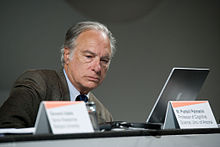
Back علم اللغة الحيوي Arabic Biolingüística Catalan Biolinguistik German Biolingüística Spanish Biolingvistika Estonian زبانشناسی زیستی Persian Biolingvistiikka Finnish Biolinguistique French Bith-theangeolaíocht Irish 生物言語学 Japanese

Biolinguistics can be defined as the study of biology and the evolution of language. It is highly interdisciplinary as it is related to various fields such as biology, linguistics, psychology, anthropology, mathematics, and neurolinguistics to explain the formation of language. It seeks to yield a framework by which we can understand the fundamentals of the faculty of language. This field was first introduced by Massimo Piattelli-Palmarini, professor of Linguistics and Cognitive Science at the University of Arizona. It was first introduced in 1971, at an international meeting at the Massachusetts Institute of Technology (MIT).
Biolinguistics, also called the biolinguistic enterprise or the biolinguistic approach, is believed to have its origins in Noam Chomsky's and Eric Lenneberg's work on language acquisition that began in the 1950s as a reaction to the then-dominant behaviorist paradigm. Fundamentally, biolinguistics challenges the view of human language acquisition as a behavior based on stimulus-response interactions and associations.[1] Chomsky and Lenneberg militated against it by arguing for the innate knowledge of language. Chomsky in 1960s proposed the Language Acquisition Device (LAD) as a hypothetical tool for language acquisition that only humans are born with. Similarly, Lenneberg (1967)[2] formulated the Critical Period Hypothesis, the main idea of which being that language acquisition is biologically constrained. These works were regarded as pioneers in the shaping of biolinguistic thought, in what was the beginning of a change in paradigm in the study of language.[3]
- ^ DEMIREZEN, Mehmet (1988). "Behaviorist theory and language learning". Hacettepe üniversitesi Eğitim Fakültesi Öğretim üyesi. https://dergipark.org.tr/tr/download/article-file/88422
- ^ Cite error: The named reference
:0was invoked but never defined (see the help page). - ^ Martins, Pedro Tiago; Boeckx, Cedric (27 August 2016). "What we talk about when we talk about biolinguistics". Linguistics Vanguard. 2 (1). doi:10.1515/lingvan-2016-0007. S2CID 131936047.